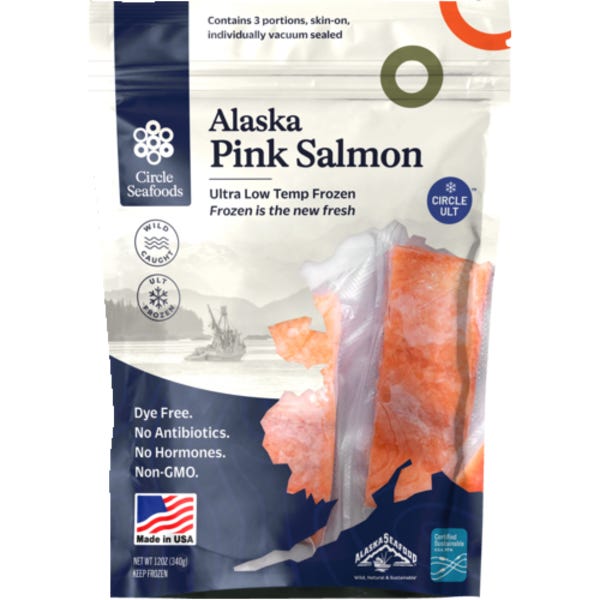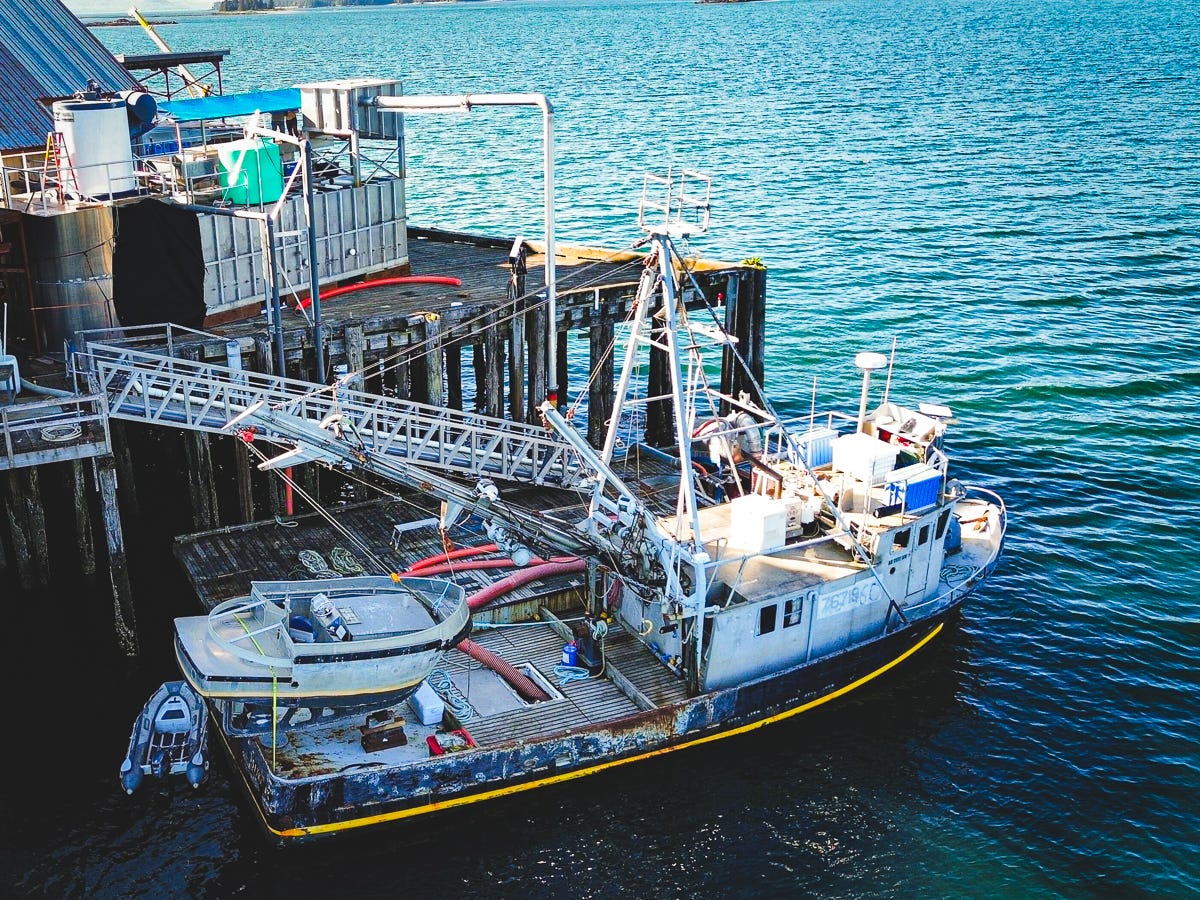By Kit Culbert, Circle Seafoods Fleet & Marketing Manager
Independent fishermen who adopt high-quality onboard practices aren’t just producing better fish. They’re creating a new class of product that deserves its own space in the market. And for that product to succeed, it must be positioned clearly and confidently as distinct from the status quo.
Anna Nelson, “Why ‘Just Caught’ Doesn’t Always Mean ‘Best’”
METLAKATLA, Alaska — Circle Seafoods is shaping the future of the salmon industry. Our new processing approach injects efficiency, fair treatment, and sustainability into the supply chain to make wild salmon more profitable, while enhancing the fishery’s quality and value. Long-term, this means economically viable harvesting, thriving communities, and strong fisheries. We’re committed to prosperity, from fishermen to families, for generations.
Our processing innovations are bringing a new class of salmon products to consumers across the United States at an affordable price point and bringing our quality-focused fleet premium prices for their catch.
Process Innovations for Quality and Consistency
Our construction team in Aberdeen, WA has built a combination floating processor, cold storage, and transportation barge, called the Circle I. With the barge, we are able to:
Drastically reduce handling by freezing large volumes of round salmon to ultra-low temperatures.
Store and transport frozen salmon out of Alaska in an unbroken cold chain at a much lower cost per pound than traditional refrigerated shipping requires.
Reprocess salmon to customer schedules and specifications in temperature-controlled environments without the pressure of peak season volumes.
Deliver a consistent, year-round supply of salmon to markets that retains its just-caught qualities.
Utilize 100% of the salmon, delivering to markets the salmon byproducts that are cost-prohibitive to process and transport in traditional models.
Above, Circle Seafoods-branded Ultra Low Temp Pink Salmon Fillets, which are in 2,400 retail stores across the United States.
The result of this process is a new class of wild pink salmon products that are delivering more value to seafood buyers, commanding higher retail prices, and driving above-market prices for Circle’s fishing fleet.
Redefining Pink Salmon
Circle Seafoods Ultra Low Temp Pink Salmon Fillets are available in 2,400 retail stores across the United States, including H-E-B and Sprouts Farmers Market. By putting our brand on a retail product, and offering it as a fillet instead of canned, we demonstrate our commitment to quality from the fishing grounds to the table.
Circle-branded blister packs of individual pre-cooked pink salmon fillets are another high-margin retail product made possible through consistent quality and smart branding. They are just one example of the innovations available to reprocessors when they are provided with a stable supply of perfectly preserved product. This product introduces wild salmon to a new audience of consumers in grab-and-go convenience store settings, where finding healthful, high-protein options can be challenging.
Below, a grab-and-go blister pack of sous vide salmon fillet.
The reimagining of an entire fish species isn’t new. Bluefin tuna, once relegated to the canned aisle of supermarkets, is now a must-have menu item in high-end sushi restaurants. The full value of bluefin was untapped until markets’ perception of the product transformed from staple to a differentiated luxury, complete with a name that confidently positions it as distinct from other tuna—hon maguro. 本 hon in Japanese means true, genuine, or origin, and is used in the Japanese name for Japan 日本 nihon, which in English can be translated literally to “the origin of the sun.” 本鮪 hon maguro refers to bluefin tuna caught in Japanese waters and can be literally translated to “bluefin tuna from the source.”
The Pacific cod fishery is going through a similar transformation, led by independent fishers like Kaia Seafoods, who are focused on quality and improved onboard handling techniques.
It has happened before, and we see a similar opportunity in pink salmon. Through improved quality practices and innovative logistics that scale and serve global markets, a new class of differentiated pink salmon products has emerged, delivering wins across the value chain from catchers to consumers and raising the value of the Southeast Alaska salmon fishery as a whole.
A Positive Feedback Loop
Stability and sustainability are core to our business model here at Circle Seafoods. In markets accustomed to yearly and seasonal volatility, we bring intrinsic value through stability. Circle’s new class of product—a consistent supply of perfectly preserved frozen salmon—stabilizes inventory for customers and raises the prices paid to fishers. When fishers are paid a fair, sustainable, and livable price for their catch, they invest in their business via vessel maintenance, safety upgrades, and hiring crew—ensuring the fleet remains active, seaworthy, and ready to respond to harvest opportunities. This, in turn, helps stabilize supply and supports the long-term viability of the fishery in a positive loop.
This model was proven in 2024, when we first sold fish that had been through our unbroken cold chain and quality program. Based on the market’s reception of the product, fishers for Circle received a $0.48/lb retro for their pinks—an almost 50% increase over the base price set in July of $0.25/lb (In salmon fisheries, a retroactive “retro” price is the final price paid to fishers by processors based on the market for their catch, usually established in the fall).
Paying this price for pinks isn’t based on speculation. It is grounded in the market’s reaction to and appetite for high-quality and mild-tasting protein sources. It also reflects the experience and investments it takes to sustainably harvest the resource.
There is untapped value in the pink salmon fishery in Southeast Alaska—for fishers and for consumers. Realizing that value will take process innovations and a commitment to quality practices at scale, and at Circle Seafoods, we are showing that it’s possible.
Kit Culbert manages the fishing fleet and marketing at Circle Seafoods. Based in Seattle in the off-season, his fishing industry experience includes grading Bristol Bay sockeye, teaching beach gangs and tender crews to identify bright chum on the Kuskokwim River, and managing the Harvester Barge floating processor. Contact Kit at fleet@circleseafoods.com if you are a southeast seiner interested in learning about joining our fleet.






